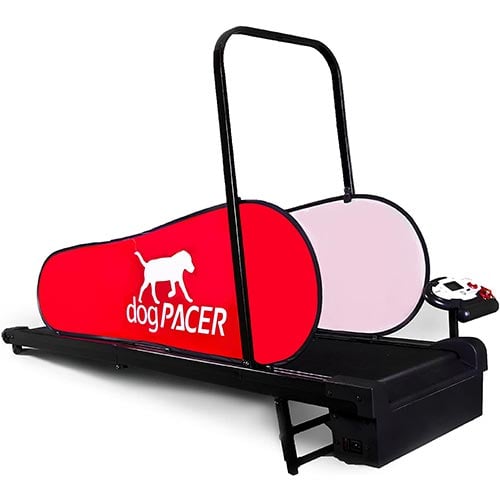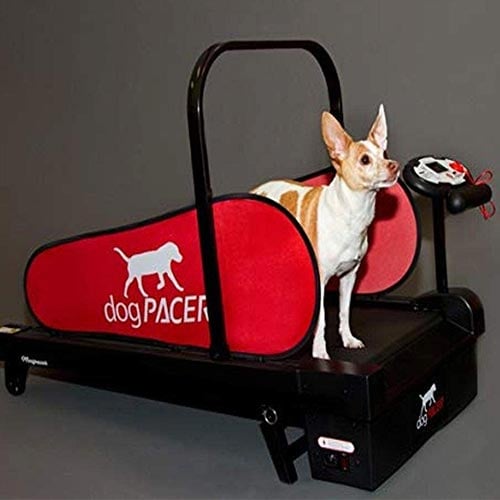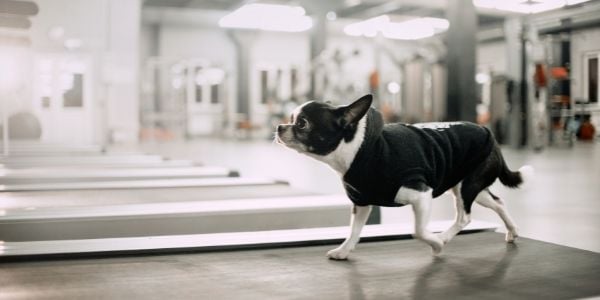 Taking your dog for their daily walks during wind, rain, ice, or snow is just not so appealing – for both you and your pup! Some dogs put on the skids when they see a raindrop and refuse to go outside.
Taking your dog for their daily walks during wind, rain, ice, or snow is just not so appealing – for both you and your pup! Some dogs put on the skids when they see a raindrop and refuse to go outside.
How can you make sure your dog gets the exercise they need when it's too cold, too rainy, or even too hot outside for a walk? Consider training your dog to use a treadmill!
Regular exercise and mental enrichment are important for our dogs, but there are reasons beyond just bad weather that make the idea of leashing up your pup for a walk less than appealing.
Your dog may become stressed or reactive on walks around the neighborhood, or you may be unable to keep up physically with your dog's exercise needs. Or perhaps you're wanting to get your dog ready for increased participation in dog sports or help them lose some weight.
An increasing number of dog owners are teaching their dogs to walk on a dog treadmill to bolster their regular exercise.
Skip Ahead
Let's look at the benefits of training your dog to use a treadmill and the important things you need to know before trying one out with your dog.
Benefits of Training Your Dog to Use a Treadmill
- Exercise during bad weather (too hot, too cold, heavy rain, or icy sidewalks, etc.)
- Weight loss
- Fitness conditioning
- Warm-up and cool-down after dog sports activities or strength conditioning exercises
- Rehabilitation after surgery or injury
- Gait analysis
- Exercise option for dogs with owners who have a disability
- Exercise option for dogs who become reactive on leashed walks
What's the Best Type of Dog Treadmill?
There are different types of dog treadmills you can choose from, depending on your goals for your dog's fitness and exercise: a traditional treadmill (motorized) or a slatmill (dog-powered). You may have also heard about hydrotherapy treadmills, which we'll also talk about further below.
Traditional Dog Treadmill
These treadmills resemble human treadmills but are longer in length and the suspension mechanisms are made specifically for four-legged users.
Pros of Electric Dog Treadmills:
- Human-controlled speed, making gait adjustments and analysis easier
- Builds endurance and aerobic conditioning
- Can be used in different ways, such as walking backward, sidestepping, etc.
- Best for dogs recovering from injury or surgery
- Often easier to train dogs to use
Cons of Electric Dog Treadmills:
- Should not be used at speeds above a trot, due to fall risk
- Longer deck length is needed for drifting forward or backward
- Can take up a lot of space
At the Preventive Vet office, we have a dogPacer treadmill set up, and Portuguese Water Dogs Clover and Finn love using it. The side panels help prevent the dog from jumping off the sides but are removable if needed.
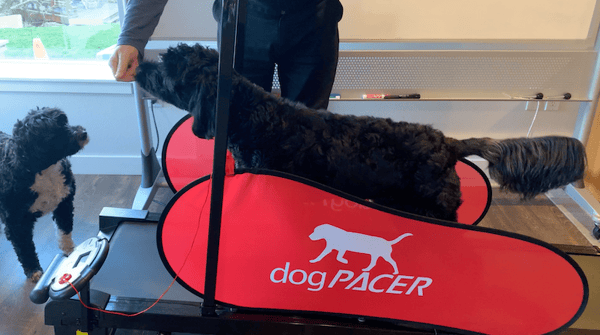
Slatmill Treadmills for Dogs
Slatmills are different from traditional treadmills because they are not powered by electricity and a computer. Instead, your dog's movement forward propels the slat deck around. Slatmills are dog-powered! Another similar option to slatmills are carpet mills, which use carpet instead of slats on the free-rotating deck.
Pros of Dog-Powered Mills:
- Gives the dog more control over their speed and this control can increase their confidence
- Decreased fall risk as the dog is attached to frame via a harness (never let your dog use any type of treadmill unsupervised)
- Higher calorie burn compared to electric mills since it focuses on anaerobic exercise
- Doesn't require as long of a deck length since the dog is attached via a harness and won't drift
Cons of Dog-Powered Mills:
- Dog controls their speed – if they don't want to go ... they don't go
- Can be harder to train a dog to use
- Often associated with dog fight rings/training, so may be illegal in certain areas
- Expensive
- Loud
- Take up a lot of space

Hydrotherapy Treadmills
Treadmills submerged underwater are used as part of a rehabilitation plan and for dogs who are overweight. The buoyancy created by the water can help reduce the impact on your dog's joints and still provide resistance during the workout.
These water treadmills are not cheap and require continued maintenance, which is usually why you'll find them at veterinary clinics or specialized rehabilitation centers. 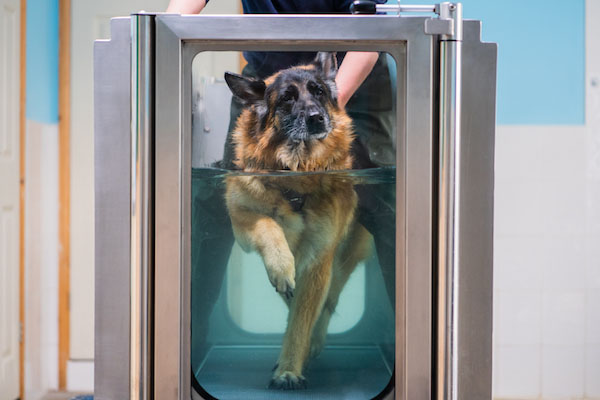
Can Your Dog Use a Human Treadmill?
While it might seem like your human treadmill can do double-duty, it is not recommended to exercise your dog on a human treadmill unless they are a toy or small breed. This is for a couple of different reasons:
- The length of the tread deck is not long enough for most dogs, causing shortening of their gait
- The suspension mechanism is different for a treadmill made for a two-legged user vs. four-legged
Treadmills made for dogs specifically are designed to provide the proper safety measures, support, and length for their intended user. However, if you have a chihuahua or other small dog, your regular treadmill can be a good option if you ensure that the length and incline of the tread deck are correct and introduce them to its use slowly and positively.
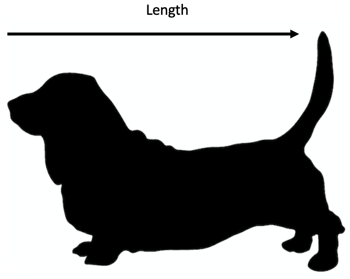 What Size of Treadmill Should Your Dog Use?
What Size of Treadmill Should Your Dog Use?
The treadmill should measure at least 2 times the length of your dog, but ideally 2.5 to 3 times their length. Measure your dog from the tip of their nose to the base of their tail, then multiply this by 2.5 to find the correct range of treadmill deck length.
For example, my Corgi measures 30 inches long from his nose to the base of his tail.
30 inches X 2.5 = 75 inches
30 inches X 3 = 90 inchesIdeal treadmill deck length = Between 6.25 to 7.5 feet (75–90 inches)
Why Treadmill Length Matters for Your Dog's Health
Ideally, your dog needs to walk, trot, or run in the middle third of the treadmill deck. Their natural gait can be altered if they are too far forward or too far back while using the treadmill. Repetitive gait changes like this can lead to gait abnormalities.
- Too close to the front of the treadmill, your dog's natural shoulder extension is shortened.
- Too close to the back, and your dog's natural hip extension is restricted.
Make sure to measure your dog prior to purchasing a treadmill so that there is enough space for them to fully extend their shoulders and hips when moving. On that note, it's also important to adjust the speed of the treadmill to help them stay within the center third of the tread deck during use.
Training Your Dog to Walk on a Treadmill
Learning to walk on a treadmill requires a lot of brainpower from your dog! Add in the fact that treadmills can be quite overwhelming with their moving surface and unfamiliar sound.
When first introducing your dog to a treadmill, make sure to start slow and create positive associations. Train in small steps and go at your dog's pace.
It's always a good idea to check with your dog's veterinarian before using a treadmill for exercise. But it's especially important to discuss treadmill use for your dog's weight loss or if they have certain medical conditions, such as heart disease, pulmonary disease, myasthenia gravis, anemia, history of collapsing trachea, etc.
This timelapse video shows the treadmill training process with Finnegan the Portuguese Water Dog, a Preventive Vet pup:
Step One: Teach Your Dog to Get On and Off the Treadmill
Start with the treadmill turned off for this step. You'll need lots of tiny high-value dog treats to reward your dog.
Use a treat to lure your dog up onto the treadmill. Say "yes!" and give them the treat when all four paws are on the tread deck. Then lure your dog off the treadmill, guiding them so they step off in a controlled manner.
Give them another treat when they get off. After a few repetitions, start saying a verbal cue to get on the treadmill, such as "hop up" or "treadmill time" as they get on. Use your dog's "off" verbal cue as they dismount.
If your dog is hesitant to get on the treadmill, don't force them! You can make this step easier by rewarding them for just putting one paw on the treadmill to start, and then build up to two paws, and eventually all four.
Step Two: Help Your Dog Get Used to the Sound of the Treadmill
You want your dog to feel comfortable with the noise of the treadmill turning on and running. Start with your dog off of the treadmill and be sure to have tiny training treats ready to give them.
Turn on the treadmill to its lowest setting. Give your dog a treat or two when they hear the sound. Then turn the treadmill off. Repeat! You are creating a positive association with the sound of the treadmill.
As your dog gets more comfortable with the sound, begin letting the treadmill run for more time, treating your dog intermittently while it's on.
Step Three: Introduce Walking on the Treadmill Slowly
Option 1: Turn on the treadmill at the lowest setting. Use high-value treats to lure your dog up onto the moving deck and encourage them to continue walking forward on the moving surface. This step can take some time to build up their confidence and familiarity with a moving surface beneath them.
Option 2: Have your dog hop up onto the treadmill and make sure they are standing squarely on the deck. Use your dog's favorite treats for this step. Turn the treadmill on at the lowest speed. Encourage your dog to walk forward and treat continuously to keep them focused on walking on the moving surface. Shower them with praise!
It's normal for a dog to act surprised and startled when the ground beneath them starts moving suddenly. For this reason, turn the treadmill off after just a couple of steps. Treat and praise heavily during this step!
When giving the treats to your dog on the treadmill, hold them directly in front of their nose. Avoid holding them too high or to the side of their head, as this makes walking straight more difficult.
As your dog begins to get the hang of it, extend the amount of time the treadmill is on before turning it off. Only practice for a minute or two at a time. Over time, you can start treating more intermittently during treadmill walks.
PRO TIP: When beginning treadmill training with your dog, make sure the treadmill is at 0% incline. You may have to put raisers under the backend of the treadmill to do this. Your dog should be comfortable with all speeds of the treadmill before adding any incline to their workouts.
Walking on an incline puts a heavier load on their rear end. Without learning the proper mechanics on the treadmill first, this means that they will pull harder from the front which could lead to gait abnormalities and injury.
Step Four: Slowly Increase Speed & Duration (Separately!)
As long as your dog is showing relaxed and happy body language, you can slowly work on increasing the speed of the treadmill. Aim for their natural walking or trotting pace. Too slow and they have to concentrate on slowing down their movements to match the speed of the treadmill. Too fast and they may not be able to keep up.
Use treats and encouragement to help them keep pace as you slowly increase the speed one point at a time.
Start with short treadmill sessions! Just like us humans, dogs need to build up their stamina and conditioning. Once you've found a speed where your dog walks comfortably, you can start to add between 2–5 minutes per day.
Our Veterinarian's Safety Tips for Treadmill Use
When your dog has mastered the treadmill, limit their treadmill exercise to no more than 30 minutes at a time. Make sure to monitor your dog during any treadmill exercise.
A dog should never be left alone while on the treadmill.
Watch your dog's respiratory rate (they shouldn't be hyperventilating!) and monitor their tongue color to be sure they aren't overexerting themselves. If you ever notice that your dog's tongue is bluish, their gums are pale, or they are excessively drooling, stop the activity immediately and contact your veterinarian.
It's normal to be tuckered out after using the treadmill, but being overly exhausted isn't good! Watch for signs of stiffness, abnormal gait, or pain the evening after and the following day after treadmill sessions.
For dogs with known osteoarthritis, icing the affected joints for twenty minutes following the workout can decrease pain, swelling, and muscle spasms. Note: Do not apply ice packs directly to the skin – wrap the ice pack in a towel before using it on your dog.
Treadmills Aren't a Substitute for All Dog Walks
While walking on a treadmill is both physical exercise and provides a mental challenge for your dog, it should not totally replace their regular walks around the neighborhood. A walk for your dog is their chance to catch up on the "pee-mail," decompress, and otherwise explore the world around them.
While incorporating treadmill walks for your dog can help burn excess energy during bad weather months, don't forget to still go for Sniffari Walks and provide lots of other dog enrichment activities.
 Important Tips for Using a Treadmill to Exercise Your Dog
Important Tips for Using a Treadmill to Exercise Your Dog
- Just like with people, it's always important to warm up and cool down before exercise. Start and end treadmill sessions at a slower pace to allow your pup to get into a rhythm.
- Avoid tethering your dog to the treadmill with a leash. If your dog slips or tries to jump off, this can cause injury, strangulation, or worse.
- If you have a long-backed dog, such as Dachshunds or Corgis, you'll want to incorporate core strengthening exercises into their routine if using a treadmill for exercise. This can help prevent back injuries. Our veterinarian also recommends long-backed dogs only use the treadmill at 0% incline.
- Should puppies use a treadmill? It's not recommended to do long durations or fast speeds on a treadmill with a puppy under 15-18 months of age, as it can potentially damage growth plates. However, that doesn't mean that you can't begin basic desensitization exercises (steps 1 and 2 above) with them when they're young. Creating a positive association with the treadmill at a young age means that using it when they are older will be a more pleasant experience for all.
- Ensure your dog's nails are at a short and proper length before using a treadmill. Long nails inhibit a dog's natural gait.
- Do a paw pad check for any cuts or cracks prior to treadmill exercise.
- Watch where you place your dog's treadmill! If it is directly facing a nearby wall or other large object, dogs may shorten their gait for fear of "running into" it.
- Keep an eye on your dog's gait while using the treadmill. You're looking for a rhythmic two-beat gait in which diagonally opposite legs move together, and your dog should not drag or favor any paw or limb.
- Do not let two dogs run on the treadmill at one time. Teach your second dog to be patient and wait their turn. Ask them to go and stay on their designated "place," or give them an enrichment activity to enjoy in a separate area.


